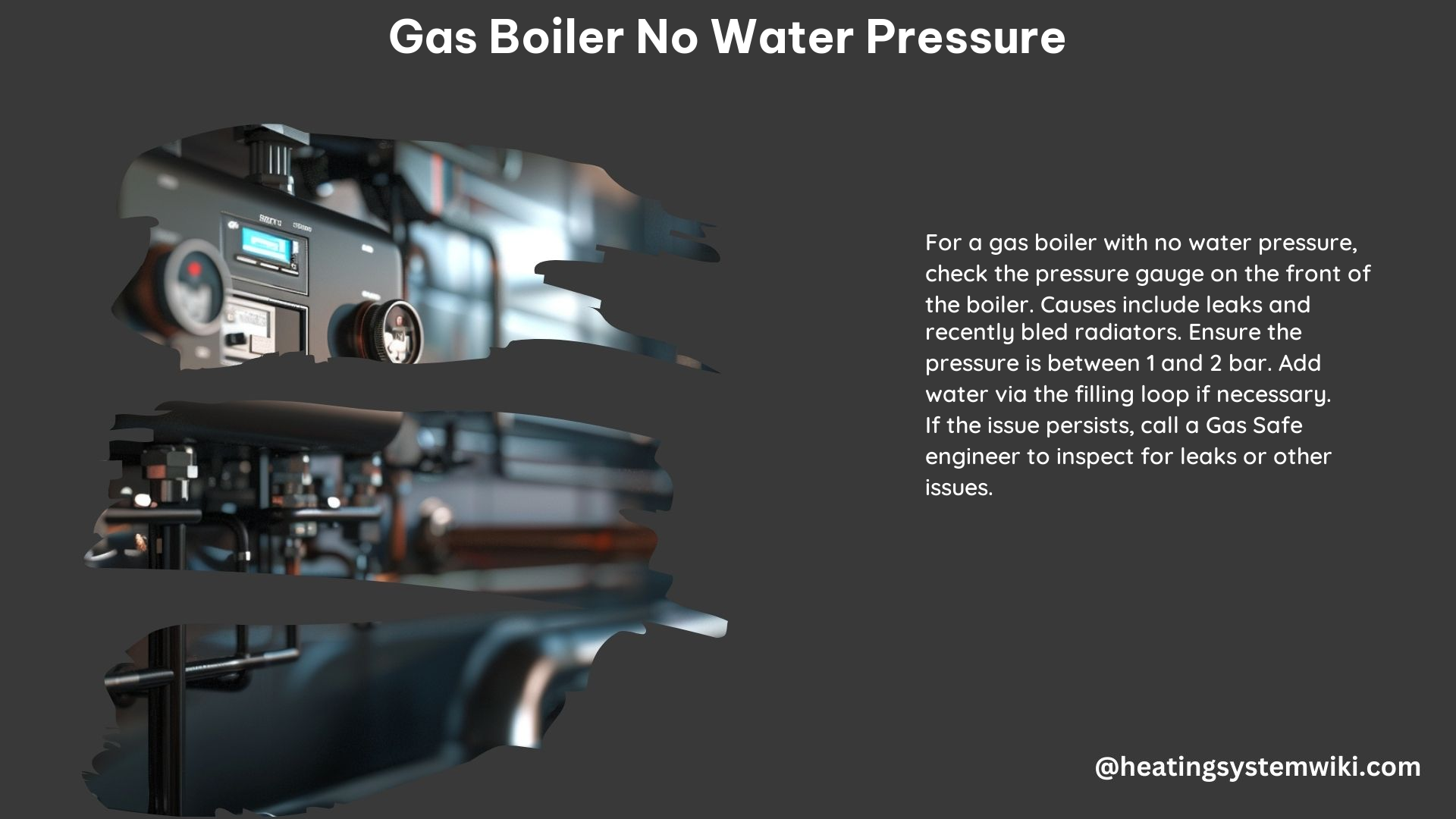Gas boilers rely on water pressure to function efficiently and provide consistent heat. Low water pressure can lead to various issues, including no heat, cold radiators, and even damage to the boiler itself. Here, we will explore the common causes of low water pressure in gas boilers, steps to diagnose and fix the problem, and technical specifications for maintaining optimal pressure.
Causes of Low Water Pressure in Gas Boilers
-
Leaks in the System: Leaks in the pipes, radiators, or boiler unit can cause water to escape, leading to low pressure. Inspect the system for signs of leaks, such as water spots or hissing sounds. Identifying and repairing leaks is crucial, as even a small leak can significantly impact the overall water pressure in the system. Use a water pressure gauge to measure the pressure before and after the repair to ensure the issue has been resolved.
-
Faulty Pressure Relief Valve: The pressure relief valve is designed to release excess pressure, but if it malfunctions, it can release too much water, causing low pressure. Check the pressure relief valve for proper operation by manually lifting the lever. If the valve is stuck open or not closing properly, it will need to be replaced. Ensure the replacement valve is rated for the appropriate pressure range, typically 1-3 bar (14.5-43.5 psi) for a standard gas boiler.
-
Expansion Vessel Issues: The expansion vessel helps maintain pressure by accommodating the expansion of water as it heats up. A faulty diaphragm or Schrader valve within the vessel can cause pressure imbalances. Check the expansion vessel’s pre-charge pressure, which should be 0.5-1 bar (7.25-14.5 psi) lower than the system’s minimum operating pressure. If the pre-charge is too low, the vessel will need to be recharged or replaced.
-
Air in the System: Trapped air in radiators can disrupt pressure. Bleed the radiators by opening the bleed valves until water flows freely, indicating the air has been released. This should help restore the proper pressure balance in the system. Regularly bleeding radiators can prevent air buildup and maintain optimal pressure.
-
Faulty Fill Valve: The fill valve is responsible for admitting water into the system. If it fails or becomes blocked, pressure will drop. Check the fill valve for proper operation and clean or replace it if necessary. Ensure the replacement valve is compatible with your boiler model and can maintain the recommended pressure range.
Diagnosing Low Water Pressure

-
Check the Pressure Gauge: The pressure gauge on the front of the boiler indicates the current pressure. A reading below 1 bar (14.5 psi) typically indicates low pressure. If the pressure is consistently low, it’s a clear sign that the system needs attention.
-
Inspect for Leaks: Look for signs of leaks, such as water spots or hissing sounds, and tighten any loose connections. Use a water pressure test kit to pinpoint the location of any leaks and quantify the pressure drop.
-
Check the Expansion Vessel: Ensure the expansion vessel is functioning correctly and not causing pressure imbalances. Use a Schrader valve tool to check the pre-charge pressure, which should be 0.5-1 bar (7.25-14.5 psi) lower than the system’s minimum operating pressure.
-
Bleed Radiators: Release trapped air in radiators to restore pressure balance. Use a radiator key to open the bleed valves until water flows freely, indicating the air has been released.
Fixing Low Water Pressure
-
Repressurize the Boiler: Use the filling loop to add water to the system until the pressure gauge reaches the recommended range, usually between 1 and 1.5 bar (14.5 to 21.75 psi). Ensure the filling loop is functioning correctly and not leaking.
-
Replace Faulty Components: If the pressure relief valve, expansion vessel, or fill valve are found to be faulty, replace them with new components that meet the technical specifications of your gas boiler model. Consult the manufacturer’s recommendations for the appropriate replacement parts.
-
Bleed Radiators: Regularly bleed radiators to prevent air buildup and maintain pressure balance. Aim to bleed the radiators at least once a year, or more frequently if you notice a drop in pressure.
Technical Specifications
- Recommended Pressure Range: 1 to 1.5 bar (14.5 to 21.75 psi). This is the optimal pressure range for most gas boilers to ensure efficient and safe operation.
- Pressure Gauge Location: Typically located on the front of the boiler, the pressure gauge provides a visual indication of the current system pressure.
- Filling Loop: Used to repressurize the boiler by adding water from the mains supply. The filling loop should be easy to access and operate, allowing you to quickly restore the proper pressure when needed.
- Expansion Vessel Pre-Charge Pressure: 0.5-1 bar (7.25-14.5 psi) lower than the system’s minimum operating pressure. This helps maintain the correct pressure balance in the system.
- Pressure Relief Valve Rating: 1-3 bar (14.5-43.5 psi) for a standard gas boiler. Ensure any replacement valve meets the technical specifications of your boiler model.
By understanding the common causes of low water pressure, the steps to diagnose and fix the problem, and the technical specifications for maintaining optimal pressure, you can effectively troubleshoot and resolve issues with your gas boiler’s water pressure. Regular maintenance and prompt attention to any pressure-related problems will help ensure your heating system operates efficiently and safely.
References:
- DoItYourself.com. (2023). Low Pressure in Boiler. Retrieved from https://www.doityourself.com/forum/boilers-home-heating-steam-hot-water-systems/645072-low-pressure-boiler.html
- DIY Stack Exchange. (2016). No Water Pressure in Heating Circuit. Retrieved from https://diy.stackexchange.com/questions/82635/no-water-pressure-in-heating-circuit
- Terry Love. (2013). Gas Boiler Hot Water Heating Water Pressure Too Low? Retrieved from https://terrylove.com/forums/index.php
- Boiler Central. (2024). Low Boiler Pressure Causes, Fixes and How to Top It Up Yourself. Retrieved from https://www.boilercentral.com/troubleshooting/low-boiler-pressure/
- Viessmann UK. (2022). What to Do If Your Boiler Pressure Is Too Low. Retrieved from https://www.viessmann.co.uk/en/heating-advice/boilers/what-to-do-if-your-boiler-pressure-is-too-low.html
